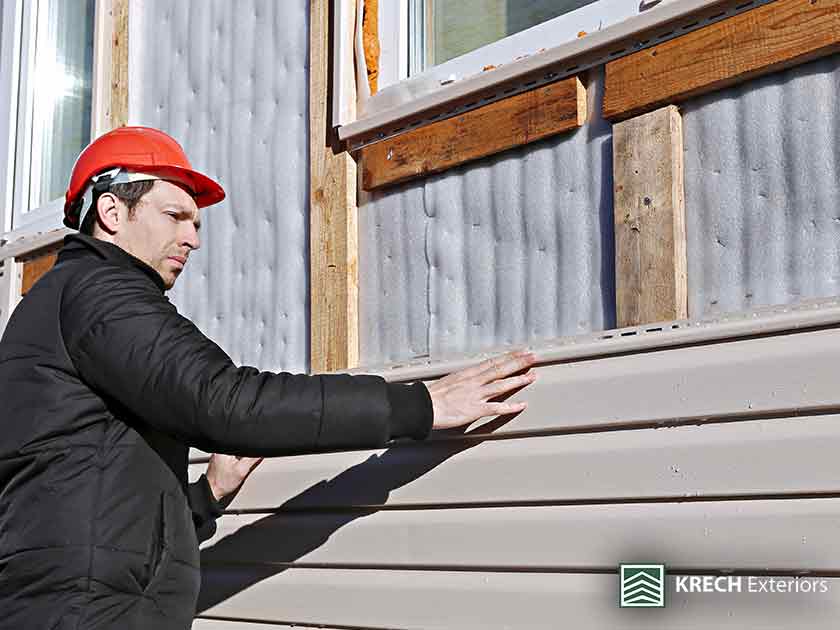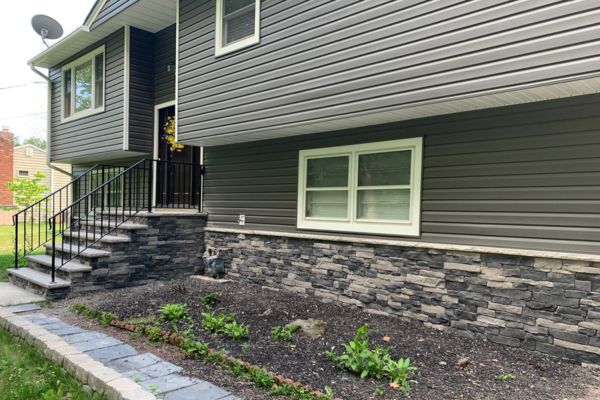The Necessary Guide to the Numerous Kinds Of Exterior Siding and Their One-of-a-kind Advantages
In the realm of home renovation, picking the best home siding is an essential choice that impacts both aesthetic appeal and useful efficiency. With so numerous options to think about, which house siding material truly stands out for your specific task?
Timber Exterior Siding
Wood siding, a popular selection for household exteriors, offers a timeless visual that integrates all-natural beauty with structural stability. This house siding material is offered in numerous designs, consisting of clapboard, roof shingles, and board-and-batten, permitting home owners to tailor their façade to match their design preferences. Wood siding is typically crafted from long lasting types such as cedar, redwood, or pine, which are recognized for their durability and capacity to endure environmental stressors.
One of the key advantages of wood exterior siding is its excellent insulation residential properties, which can add to power performance and lower heating prices. Additionally, wood exterior siding is biodegradable, making it an environmentally pleasant choice when sourced sustainably. Regular upkeep, including painting or discoloration, can lengthen its life expectancy and boost its appearance, allowing homeowners to maintain the all-natural beauty of the wood.
Nonetheless, possible drawbacks include susceptibility to parasites, rot, and weather condition damage, demanding sufficient treatment and maintenance - morris siding contractor. Despite these concerns, when properly looked after, timber home siding can supply a long lasting and attractive solution that improves the personality of a home while providing a cozy, inviting atmosphere

Vinyl Home Siding
Vinyl siding has actually become a leading choice for home owners seeking a low-maintenance exterior alternative that incorporates toughness and cost. This flexible material is crafted from polyvinyl chloride (PVC), making it immune to various climate problems, consisting of dampness and UV rays. Consequently, vinyl home siding does not warp, rot, or discolor, making certain lasting visual appeal.
Among the primary advantages of vinyl exterior siding is its extensive array of styles and colors, enabling homeowners to accomplish the desired try to find their property without the demand for regular repainting. In addition, plastic siding is simple to mount, which can considerably minimize labor prices throughout building or remodelling projects.
Vinyl home siding also adds to energy performance. Lots of choices feature insulation backing, which improves thermal performance, helping to preserve comfortable interior temperature levels and possibly lowering energy costs. Additionally, its smooth surface area assists in simple cleaning, calling for only periodic washing with a garden tube to get rid of dust and debris.
Fiber Cement House Siding
Fiber concrete siding has actually obtained traction amongst homeowners and builders alike due to its impressive combination of longevity and visual convenience. Made up of a mixture of cellulose, sand, and cement fibers, this siding option is crafted to hold up against severe climate condition, consisting of high winds, heavy rain, and temperature fluctuations, making it a long-lasting selection for residential exteriors.

Among the primary benefits of fiber cement exterior siding is its resistance to bugs, such as termites, and its non-combustible nature, offering enhanced fire security. morris siding contractor. In addition, it is available in a wide range of designs, shades, and appearances, permitting house owners to accomplish their wanted aesthetic without compromising performance
An additional advantage is its low upkeep needs; fiber concrete exterior siding normally needs paint or staining every 5-10 years, which is less frequent than other materials. Its long life contributes to a reduced overall cost of ownership, as it lowers the need for frequent repair work or replacements.
Inevitably, fiber cement exterior siding stands for an exceptional investment for those looking for a durable, appealing, and functional outside option, integrating both kind and feature to improve the home's aesthetic allure.
Metal Exterior Siding
The attraction of metal home siding depends on its robust durability and modern-day visual allure, making it a favored option for modern style. Offered in products such as light weight aluminum and steel, steel home siding supplies a variety of surfaces link and shades, permitting property owners to attain a personalized look that matches their style vision.

Energy efficiency is another substantial he has a good point advantage, as numerous metal exterior siding products are developed with insulation choices that help regulate indoor temperatures. This can lead to reduced energy prices with time. In addition, steel home siding is usually recyclable, making it an eco-friendly selection for sustainability-minded house owners.
The setup process for metal siding can be reasonably uncomplicated, causing a quicker turnaround time for building projects. Overall, steel home siding integrates functionality and design, making it a sensible choice for those seeking a long-lasting and aesthetically appealing outside coating.
Brick and Rock Home Siding
Brick and rock exterior siding stands apart as a classic option that improves the visual appeal of any home. Recognized for their sturdiness and low upkeep, these products give an extraordinary roi while boosting the building's curb appeal. Available in different colors, structures, and patterns, block and stone can be tailored to fit diverse building styles, from traditional to modern-day.
Among the primary benefits of brick and rock house siding is their energy effectiveness. Both products have all-natural insulating residential properties that help control interior temperature levels, possibly reducing heating and cooling expenses. Additionally, they provide remarkable fire resistance contrasted to various other siding options, adding to enhanced security.
Another benefit is their longevity. Brick and stone can last for decades, typically needing very little maintenance past occasional cleansing. Unlike timber siding, they are impervious to insects and rot, guaranteeing a lasting exterior that endures the elements.
Conclusion
In summary, the selection of siding considerably impacts a home's aesthetic allure, power efficiency, and maintenance requirements. Each kind of house siding-- whether timber, plastic, fiber cement, brick, or steel and rock-- supplies one-of-a-kind advantages tailored to various homeowner choices and ecological conditions. Understanding these alternatives allows informed choices that boost both the durability and aesthetic appeal of residential outsides. Eventually, choosing the appropriate he said home siding is crucial for accomplishing a balance in between performance and design in household design.
One of the main advantages of wood house siding is its outstanding insulation residential or commercial properties, which can add to energy effectiveness and reduced home heating costs. Furthermore, wood exterior siding is eco-friendly, making it an ecologically pleasant alternative when sourced sustainably.One of the primary benefits of steel house siding is its resistance to different ecological factors.Energy effectiveness is an additional significant advantage, as numerous steel house siding items are created with insulation alternatives that help regulate indoor temperature levels. Each type of home siding-- whether timber, plastic, fiber cement, metal, or brick and rock-- supplies distinct advantages tailored to different house owner preferences and ecological conditions.